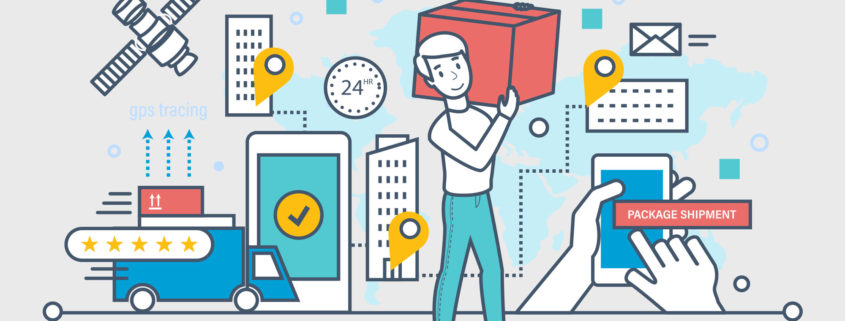6 Signs That It’s Time to Redesign Your Supply Chain Strategy
As the eCommerce industry continues to grow at an alarming rate, supply chain managers and logistics companies are rethinking their fulfillment strategies. In the fast-paced digital world, these companies need to do more with less, completing thousands of orders with less time to spare.
With Amazon raising consumer expectations for fast, timely deliveries, some logistics companies are struggling to keep up. According to Forbes, 44 percent of participating companies state that the Amazon effect is having a dramatic impact on their logistics, supply chain and transportation operations.
New supply chain technology, such as an automated warehouse system, the IoT and other digital tools, are changing the way the industry thinks about the supply chain. If your company has yet to implement this new technology or you’re starting to see cracks in the foundation of your services, it may be time to rethink your supply chain strategy. Here are six signs that your logistics company needs a facelift.
1. Items Regularly Go Missing
Every supply chain manager’s nightmare, losing products in your facility or along the supply chain can infuriate your customers and affect your bottom line. With so many products and SKUs to keep track of, this issue can crop up again and again for some logistics companies. Some companies even keep extra inventory on the shelf in case something goes missing.
Maybe these items are placed on the wrong shelf, sent to the wrong address or simply vanished into thin air, but you’ll never know unless you have a way of tracking individual products as they move through your supply chain. Attaching real-time GPS tracking devices to your products and packages helps you keep track of these items in real-time. Surprisingly enough, 46 percent of SMBs either don’t track inventory or use a manual method.
While some missing products may be a minor inconvenience, you could spoil a fruitful relationship with one of your clients if some of their products never make it to their destination.
2. You Can’t Find What You Need in Your Warehouse
Have you or one of your employees ever looked for products on the shelf only to come up empty-handed? Time is of the essence when it comes to filling orders and getting packages out the door. If your warehouse is disorganized, it may take your employees a while to find what they need. SKUs and labels may be missing, products may end up in the wrong bin or too many different products may be placed in the same container.
To speed up the fulfillment process, learn how to organize a warehouse in a way that makes sense for your business and your employees. Use stack racks to make the most of your warehouse space with individual shelves reserved for similar types of products. Use proper signage to help your employees find their way through your facility. If you’re putting too many items in the same bin, invest in industrial storage bins and nesting nodes to separate dissimilar items.
3. There’s No Buffer When Things Go Wrong
As a supply chain manager, you always need to be prepared for the worst. You may encounter an unexpected delay in your supply chain, such as one of your trucks getting stuck in transit or one of your suppliers falling behind on their order. But, then, one of your automatic pickers and stockers or your supply chain management software suddenly stops working, sending your entire warehouse into chaos. It may take you days or even weeks for things to get back to normal, leading to all kinds of costly delays and angry customers.
That’s why you need to pad your supply chain with plenty of buffers, so you’re not scrambling to fulfill orders when something goes wrong. Keep a backup of your supply chain management software so you can still monitor activity and get products out the door if you encounter some IT problems. Regularly maintain your equipment and keep a backup unit onsite in case one of these machines unexpectedly bites the dust. Train your employees to do things by hand in case you lose access to certain machines and automated tools.
4. Demand Is Growing Faster Than Your Logistics Team
With SKU proliferation on the rise, you and your team may find yourselves struggling to keep up with demand. Every time a new product gets released into the supply chain or your business takes on a new customer, your supply chain needs to ready for this surge in demand. You should always have a little extra room on the shelf for new products and more machines, vehicles and staff members to fulfill these extra orders.
If you take on a new client or new product without first making room in your supply chain, you could stretch your existing resources too far, resulting in delays and poor customer service. Collect data on your operations and use predictive analysis to anticipate future demand and staff your warehouse facility accordingly.
5. You Can’t Access Supply Chain Reports in Real-Time
If you’re not already using a supply chain management software program, now is the time. These programs keep you informed every step of the way, so you don’t have to wait around for the system to generate a report, which may be out-of-date by the time it hits your desk. From inventory levels to customer fulfillment rates, things are always changing in the supply chain business. Not having immediate access to this information can quickly derail your business, forcing you to react to these changes instead of being proactive with your operations.
6. Your Competitors Have Better Fill Rates
If your competitors regularly outdo your logistics company when it comes to fulfilling orders, timely delivery and keeping in-demand products in stock, you will eventually lose some of your customers. Incorporate the tips mentioned above into your supply chain strategy, so you don’t get left in the dust. Investing in the latest technology and organizing your warehouse will help you keep up with future demand. The e-commerce industry will only continue to grow, so start redesigning your strategy today if you want to stay competitive for years to come.













